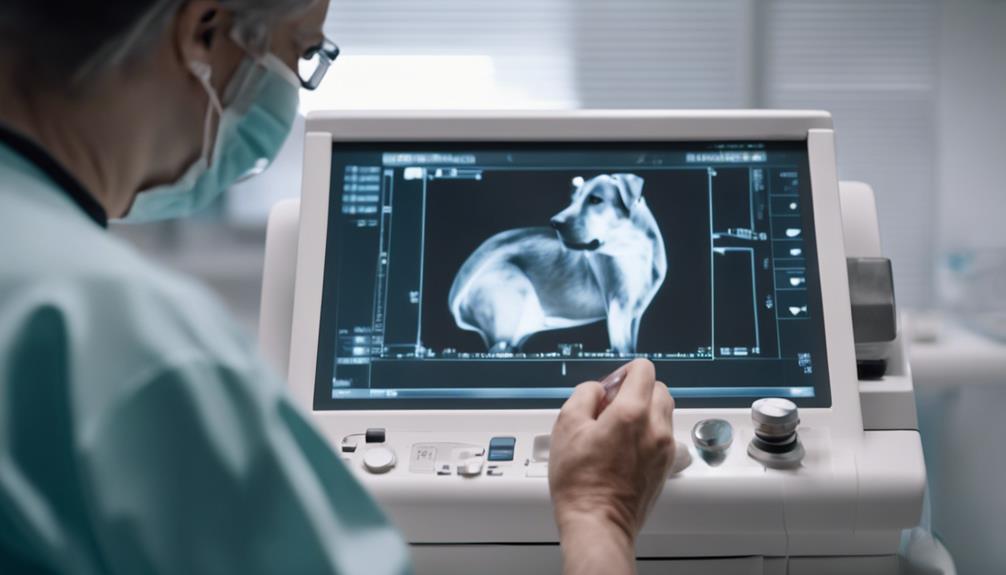Dilated Cardiomyopathy (DCM) in dogs is a complex cardiac condition that demands attention due to its impact on heart function.
From the subtle signs that may go unnoticed to the critical need for early detection, DCM poses challenges that require a nuanced understanding for effective management.
By exploring the intricacies of this condition, individuals can equip themselves with the knowledge necessary to navigate the complexities of DCM in their beloved pets.
Understanding the depths of DCM is not just a matter of awareness but a crucial step towards ensuring the well-being of canine companions.
Key Takeaways
- DCM weakens heart muscles, affecting large breeds primarily.
- Genetics, nutrition, and toxins play roles in DCM development.
- Symptoms progress from exercise intolerance to CHF signs.
- Diagnosis involves heart tests, and treatment aims to manage symptoms.
Definition of Dilated Cardiomyopathy (DCM)
Dilated Cardiomyopathy (DCM) in dogs is a condition characterized by the weakening of the heart muscles, leading to inefficient blood pumping and structural changes in the heart chambers.
This weakening causes the heart muscle to thin, resulting in the enlargement of the heart chambers. DCM commonly affects middle-aged and senior large or giant breed dogs, with a primary impact on the left side of the heart.
This can lead to blood backup in the lungs, causing issues with oxygenation. While less frequent, DCM can also affect the right side of the heart. Understanding the definition of DCM is crucial in recognizing the signs and symptoms early on to provide timely intervention and management for affected dogs.
Impact on Heart Muscles
The weakening of the heart muscles in dogs with Dilated Cardiomyopathy (DCM) results in compromised blood pumping efficiency and significant structural alterations within the heart chambers. This weakening leads to a decrease in the heart's ability to effectively pump blood throughout the body, causing a range of symptoms associated with heart failure.
The thinning of the heart chamber walls and enlargement of the chambers further exacerbate the heart's inability to function optimally. As the heart struggles to pump blood efficiently, the chambers may enlarge to compensate for the decreased pumping capacity. These structural changes not only impact the heart's ability to circulate blood but also contribute to the progression of heart failure in dogs affected by DCM.
Factors Contributing to DCM

Factors contributing to DCM in dogs include genetic predispositions, nutritional deficiencies, toxins, infections, and potential dietary influences.
- Genetic Predispositions: Breeds like Boxers, Great Danes, and Doberman Pinschers are genetically prone to DCM.
- Nutritional Deficiencies: Taurine and l-carnitine deficiencies can play a role in the development of DCM.
- Toxins and Infections: Exposure to certain toxins and infections can contribute to the onset of DCM in dogs.
- Potential Dietary Influences: There is ongoing research investigating a possible link between grain-free diets and DCM in dogs not genetically predisposed. The FDA is actively looking into this connection to better understand the role of diet in DCM development.
Recognizing Signs and Symptoms
Recognizing the signs and symptoms of Dilated Cardiomyopathy (DCM) in dogs is crucial for early detection and intervention in affected animals. Early-stage symptoms include exercise intolerance, while progression can lead to fainting, lethargy, and rapid breathing. Signs of left-sided congestive heart failure (CHF) may include coughing and weakness, and later stages could present with reduced appetite and a swollen belly. In severe cases, sudden collapse and difficulty breathing may occur. Detecting these indicators promptly can help in initiating appropriate treatment and improving the quality of life for dogs with DCM.
| Symptoms | Description | Symptoms | Description |
|---|---|---|---|
| Exercise Intolerance | Reduced ability to engage in physical activities | Weakness | Lack of strength or energy |
| Fainting | Temporary loss of consciousness | Rapid Breathing | Abnormally fast breathing |
| Coughing | Audible expulsion of air from the lungs | Swollen Belly | Abdominal distension |
Diagnosing DCM in Dogs

Early detection through comprehensive diagnostic methods plays a crucial role in effectively diagnosing Dilated Cardiomyopathy (DCM) in dogs. When suspecting DCM, veterinarians typically follow a structured approach to confirm the diagnosis:
- Physical Examination: Assessing vital signs, lung sounds, and overall condition.
- X-rays: Revealing heart size and any signs of congestion in the lungs.
- Electrocardiography (ECG): Recording the heart's electrical activity to detect irregularities.
- Echocardiography: Providing detailed images of the heart's structure and function, crucial for confirming DCM.
These diagnostic tools help veterinarians accurately diagnose DCM in dogs, enabling prompt initiation of appropriate treatment interventions.
Treatment Approaches for DCM
Effective management of Dilated Cardiomyopathy (DCM) in dogs involves a multifaceted approach integrating various treatment modalities. Treatment for DCM aims to reduce symptoms and slow disease progression.
This typically includes the use of medications such as diuretics to remove excess fluid and improve heart function. Angiotensin-converting enzyme inhibitors are commonly prescribed to promote heart health.
Additionally, dietary changes may be recommended to support heart function, such as increasing taurine and l-carnitine intake.
Regular monitoring by a veterinarian is crucial to adjust treatment plans as needed and ensure the best possible outcome for dogs with DCM.
Prognosis and Management

Moving forward from discussing treatment approaches for Dilated Cardiomyopathy (DCM) in dogs, understanding the prognosis and management of this condition is paramount in ensuring optimal care and outcomes for affected animals. When dealing with DCM in dogs, the following points are crucial for effective management:
- Regular veterinary check-ups to monitor heart function and adjust treatment as needed.
- Compliance with medication schedules and recommended dietary changes to support heart health.
- Implementing a low-sodium diet to reduce fluid retention and strain on the heart.
- Providing a low-stress environment and appropriate exercise levels to maintain overall well-being.
Additional Resources and References
Amid the evolving landscape of veterinary care, accessing comprehensive resources and reputable references is paramount for gaining a deeper understanding of Dilated Cardiomyopathy (DCM) in dogs. Below is a curated list of additional resources and references that can provide valuable insights into DCM in dogs:
| Resource | Description |
|---|---|
| American College of Veterinary Cardiology | Offers guidelines and research on DCM diagnosis and management. |
| Tufts University Cummings Veterinary Medical Center | Provides educational materials on DCM and its treatment options. |
| Veterinary Information Network (VIN) | Online community for veterinary professionals with discussions on DCM cases and treatments. |
Conclusion
In conclusion, Dilated Cardiomyopathy (DCM) in dogs is a serious cardiac condition characterized by heart muscle weakening and impaired blood circulation. Understanding the causes, symptoms, and treatment options for DCM is crucial for early detection and effective management.
By recognizing the signs and seeking prompt veterinary care, pet owners can improve their canine companions' prognosis and quality of life. Stay informed and proactive in monitoring your dog's cardiac health to ensure their well-being.




